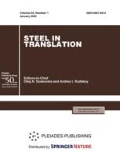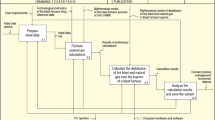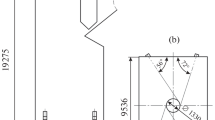Abstract
The article considers a mathematical model of the combustion zone of a blast furnace working with the use of the injection of coal-dust fuel. In this model, two subsystems were identified: (1) subsystem of heating the particles of coal dust and volatiles released in the combustion zone; (2) subsystem of heat exchange and combustion processes in the tuyere. A two-dimensional velocity field of gas in the combustion zone was investigated. The combustion processes are considered as a set of simultaneously developing phenomena of coke burning in a layer, single pieces of coke and particles of coal dust. The model includes the following equations: total gas mass balance, gas component mass balance, gas heat balance, movement of coal dust particles, and heat balance of coal dust particles. The model calculates maximum burning temperature in the combustion zone, the distance from the cut of the tuyere to the focus of combustion, the length of the oxygen combustion zone, gas temperature, the content of gas phase components, and the degree of carbon burnout of pulverized coal at the outlet of the tuyere combustion zone. An information-modeling system has been developed. It allows for the investigation of the influence of combined blast characteristics, the properties of coke and coal-dust fuel, the geometric dimensions of tuyeres, and other factors on the temperature fields and concentrations of components of the gas phase in the combustion zone. The model also helps to select a rational mode of pulverized coal that will ensure completeness of its combustion in the tuyere combustion zone. The main functions of the program are as follows: representation of results of calculation in form of tables and diagrams, storage of options of basic data in a database, and export of results of calculation to Microsoft Excel. Conclusions were made on the reduction of the combustion temperature in the combustion zone and the approach of the focus of combustion to the tuyere when pulverized coal was injected. The authors also have established the need to use coals with certain quality characteristics and place where coal dust was introduced into the blast stream.





Similar content being viewed by others
REFERENCES
Efimenko, G.G., Gimmel’farb, A.A., and Levchenko, V.E., Metallurgiya chuguna. Uchebnik dlya vuzov (Ironmaking: Manual for Higher Education Institutions), Kiev: Vyshcha Shkola, 1988.
Pliskanovskii, S.T. and Poltavets, V.V., Oborudovanie i ekspluatatsiya domennykh pechei (Equipment and Operation of Blast Furnaces), Dnepropetrovsk: Porogi, 2004.
Dunaev, N.E., Kudryavtseva, Z.M., and Kuznetsov, Yu.M., Vduvanie pylevidnykh materialov v domennye pechi (Blasting of Pulverized Materials into Blast Furnaces), Moscow: Metallurgiya, 1977.
Kochura, V.V., Yaroshevskii, S.L., Kupenko, V.I., and Mishin, I.V., Method of determining the degree of combustion of pulverized-coal fuel in blast furnaces, Metallurgist, 2013, vol. 57, nos. 7–8, pp. 671–681.
Kochura, V., Yaroshevskiy, S., Popov, V., and Braga, V., Fundamentals aspects and industrial practice of coal injection in the blast furnace at Donetsk Metallurgical Works, Proc. 4th Int. Congress on the Science and Technology of Ironmarking, Yokohama, 2006, pp. 331–334.
De Castro, J.A., da Silva, A.J., Sasaki, Ya., and Yagi, J., A six-phase 3-D model to study simultaneous injection of high rates of pulverized coal and charcoal into the blast furnace with oxygen enrichment, ISIJ Int., 2011, vol. 51, no. 5, pp. 748–758.
Chung, J.K., Han, J.W., and Lee, J.H., Coke properties at tuyere level in blast furnace with pulverized coal injection, Met. Mater., 1996, vol. 2, no. 1, pp. 1–7.
Jiang, X., Li, J., and Qiu, J., Study on combustion characteristic of micro-pulverized coal, Zhongguo Dianji Gongcheng Xuebao, 2000, vol. 20, no. 6, pp. 71–74.
Tovarovskii, I.G. and Merkulov, A.E., Blast-furnace smelting with coal-dust injection, Steel Transl., 2012, vol. 42, no. 1, pp. 28–40.
Tovarovskii, I.G. and Merkulov, A.E., Analysis of blast-furnace smelting with the injection of natural gas and coke-oven gas, Steel Transl., 2012, vol. 42, no. 1, pp. 28–40.
Su, B.X., Zhang, J.L., Liu, Q.Y., Che, X.-M., Fu, Y.D., and Jin, J.Q., Study on the combustion process of pulverized coal and carbonaceous matter dust in BF, Proc. AIST Steel Properties and Applications Conf. Combined with MS&T'11, Warrendale, PA: Assoc. Iron Steel Technol., 2011, vol. 1, pp. 536–544.
Zolotukhin, Yu.A., Andreichikov, N.S., and Kukolev, Ya.B., Quality requirements on coke for blast furnaces operating with coal-dust fuel, Coke Chem., 2009, vol. 52, no. 3, pp. 110–115.
Wu, K., Ding, R., Han, Q., Yang, S., Wei, S., and Ni, B., Research on unconsumed fine coke and pulverized coal of BF dust under different PCI rates in BF at Capital Steel Co, ISIJ Int., 2010, vol. 50, no. 3, pp. 390–395.
Jaffarullah, R. and Ghosh, B.K., Alternate fuels in blast furnaces to reduce coke consumption, J. Inst. Eng. (India), Part MM,Min. Metall. Div., 2005, vol. 86, pp. 16–23.
Spirin, N.A., Shvydkii, V.S., Lobanov, V.I., and Lavrov, V.V., Vvedenie v sistemnyi analiz teplofizicheskikh protsessov v metallurgii. Uchebnik posobie dlya vuzov (Introduction into System Analysis of Thermophysical Processes in Metallurgy: Manual for Higher Education Institutions), Yekaterinburg: Ural. Gos. Tekh. Univ., 1999.
Onorin, O.P., Spirin, N.A., Terent’ev, V.L., et al., Komp’yuternye metody modelirovaniya domennogo protsessa (Computer Modeling of Blast Furnace Process), Spirin, N.A., Ed., Yekaterinburg: Ural. Gos. Tekh. Univ.–Ural. Politekh. Inst., 2005.
Spirin, N.A., Shvydkii, V.S., Ovchinnikov, Yu.N., and Lavrov, V.V., Mathematical modeling of heat transfer in combustion zone of blast furnace, Izv. Vyssh. Uchebn. Zaved., Chern.Metall., 1998, vol. 41, no. 4, pp. 51–53.
Pavlov, A.V., Polinov, A.A., Spirin, N.A., Onorin, O.P., and Lavrov, V.V., Use of model systems for solving new technological problems in blast-furnace production, Metallurgist, 2017, vol. 61, nos. 5–6, pp. 448–454.
Pomerantsev, V.V., Aref’ev, K.M., Akhmedov, D.B., et al., Osnovy prakticheskoi teorii goreniya (Fundamental Practical Theory of Combustion), Leningrad: Energoatomizdat, 1986.
Shvydkii, V.S., Bykov, A.G., Lugovykh, G.A., and Karymov, R.R., Gasification of coal dust particles in a blast furnace unit, Izv. Vyssh. Uchebn. Zaved., Chern.Metall., 2008, vol. 51, no. 4, pp. 7–10.
Volkov, E.A., Chislennye metody. Uchebnik posobie dlya vuzov (Numerical Methods: Manual for Higher Education Institutions), Moscow: Nauka, 1987.
Author information
Authors and Affiliations
Corresponding authors
Additional information
Translated by A. Simakova
About this article
Cite this article
Shvydkii, V.S., Kudelin, S.P., Gurin, I.A. et al. Development of an Information Modeling System of Coal-Dust Fuel Injection into Tuyeres of a Blast Furnace. Steel Transl. 49, 854–861 (2019). https://doi.org/10.3103/S0967091219120106
Received:
Revised:
Accepted:
Published:
Issue Date:
DOI: https://doi.org/10.3103/S0967091219120106




